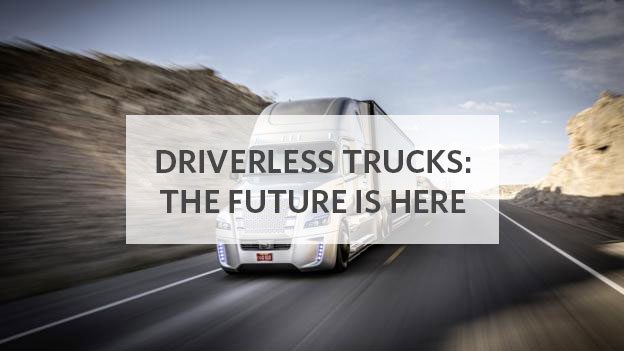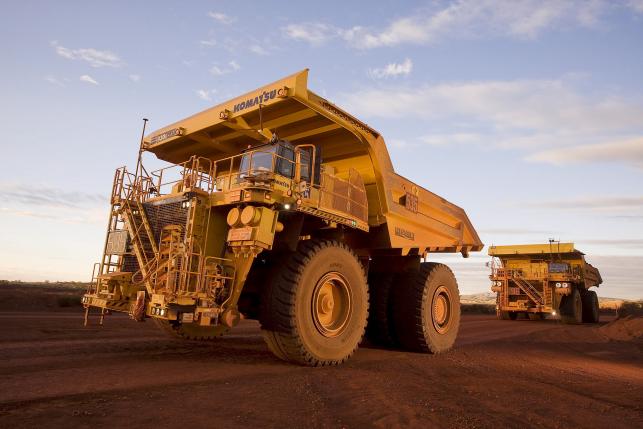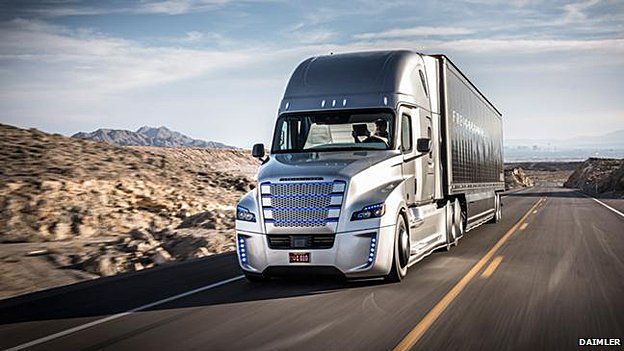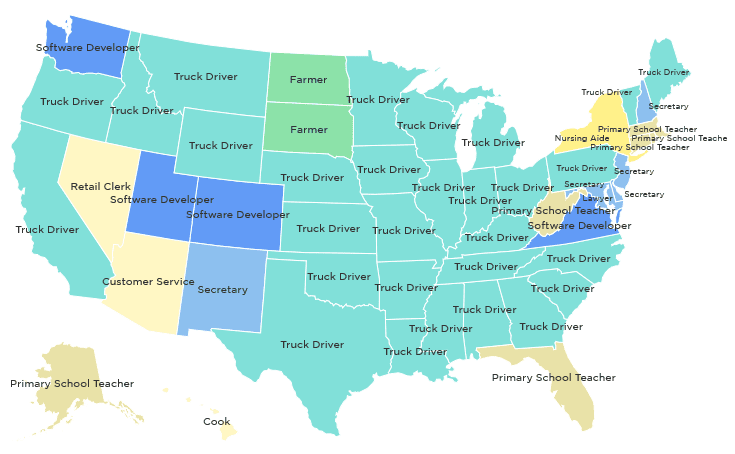Could driverless trucks be the end of heavy vehicle fatalities?
Industry Trends | By | 1 Feb 2016 | 7 minute read

Jobs in a range of industries have been enhanced by machine intervention over the years. Truck drivers it seems are next on the list, with the likes of Google, Uber, and Tesla all working to bring driverless vehicles to life. Automation in the vehicle industry is already underway, with Google trialling driverless cars and now Singapore with driverless trains.
Autonomous vehicle systems can help reduce driving stress and cut the amount of time drivers are in control during long-haul journeys, resulting in a positive effect on driver health.
In recent times, the trucking industry has been subject to a huge driver shortage, although being dubbed as one of the most popular jobs in 29 states in the United States, according to U.S. Census data.
In 2012 in the U.S., 330,000 large trucks were involved in crashes that killed 4,000 people, most of them in passenger cars. About 90 per cent of those were caused by human error. Automation appears to be the answer to road safety issues with long-haul journeys. When operating in autonomous mode, sleepiness was reduced by as much as 25 per cent in research measuring the brain activity of drivers on long stretches.
Despite driverless trucks being autonomous, they are not in fact “driverless” meaning they won’t be taking drivers out of their seats anytime soon. The human eye and brain gets input from your surroundings 10 times a second. When you’re driving, you must be able to process that information and make the right decision 10 times a second, something that so far software hasn’t been able to replicate, which is why a “safety” driver is still needed for driverless trucks.
Fully automatic
Within Australia, Rio Tinto uses driverless trucks and drill rigs to help operate its iron mines in Pilbara. The trucks are remotely controlled by computer jockeys 1,500km away in Perth.
Greg Lilleyman, Group executive of Technology & Innovation, said that their fleet of robotics has outperformed the manned fleets by 12 per cent. They also see a proportionate saving in haul and load costs due to the robotics’ better efficiency.
Vehicles aren’t the only one going through a transformation. History has shown us that back in the 1950s, commercial aircraft’s typically had five cockpit crew members, a captain, first officer, flight engineer, navigator and radio operator. But by the 1980s, the numbers required on the flight deck had been reduced to two because computers were able to fill most of the tasks previously performed by humans.
In 2019, the state of NSW in Australia plans to open the north-west rail link in Sydney as the first fully autonomous rail service in the country. Many other major urban metro lines already operate driverless trains such as Singapore and France. After Google’s success in the United States, South Australia has just allowed for tests of driverless cars on public roads.
Self-driving trucks are no longer the future – they’re here
In May 2015, Daimler, an automotive giant in the U.S. tested a vehicle on a public highway in Nevada, which was one of the first states to pass legislation for the driverless trucks trial.
Dubbed the Freightliner Inspiration, the truck can drive autonomously on open stretches of road using a GPS, radar and video cameras. A driver sits in the seat to be on hand if the truck alerts the driver that something is wrong. Having a “safety” driver is a must in case an issue arises.
Daimler’s truck only works on open roads as city streets are far more complicated to navigate. Germany consultancy Roland Berger believes that by 2030, these issues will no longer be there and humans won’t be needed to drive trucks at all.
Why the need for driverless trucks? Daimler believes their autonomous trucks can alleviate the burden on long-haul journeys, reduce driver fatigue and limit driver error. The system is also said to be 5 per cent more fuel efficient.
Driverless vehicles and jobs
If the brains behind driverless vehicles succeed and it’s fairly likely they will; this could render the end for truck jobs in the U.S. If you look at this numerically, it could result in 3.5 million drivers and 5.2 million additional personnel within the industry out of a job. Not to mention the countless pit stops on desolate roads and highways that the industry keeps alive.
One look at this map shows how dependent the U.S. economy is on truck drivers.
This information, however, is in stark contrast to reports of shortages of truck drivers in the U.S. The American Trucking Associations (ATA) estimated in 2014 that the country had a 30,000 shortage of truck drivers. The causes are said to be due to industry growth, retirements and drivers switching to other industries. The ATA estimates that the industry needs an average of 100,000 new drivers each year over the next decade to fill the skill shortage.
Critics have been quick to pronounce driverless trucks as the end of the American trucking industry, but the figures present an opportunity for driverless vehicles to improve productivity, safety and fill the shortage gap.
New opportunities
Although traditional jobs will be affected, the industry will also bring about new job opportunities. The driverless truck network will create a need for network installers and manufacturers to produce ‘connected parts.’ With the emergence of self-driving technology, there’s also a surge in the demand for specific vehicle components to support such advancements. Source One helps meet this need by supplying quality parts that enhance vehicle safety and efficiency during automation. Communication systems will need to be built so driverless vehicles can talk to each other. The Daimler driverless truck doesn’t make decisions by only using its own sensors, it also relies on data exchanged from other vehicles.
The Highway Pilot technology featured in this truck uses a combination of radar sensors at the front and sides of the truck, a stereo camera behind the windshield, 3D maps, vehicle to vehicle and vehicle to infrastructure communication.
Driverless trucks can also platoon, which uses the vehicle to vehicle communication system, cruise control, collision avoidance systems, the radar sensor and GPS to allow the trucks be in tight formation on the road at high speeds. The trucks are constantly communicating, with the lead truck sending signals to the others. If there is a collision on the road ahead, the lead truck will activate its cruise control to slow down resulting in the trucks behind to do the same.
Future driving could look like this: autonomous and connected.
And what about monitoring the driverless network? Jobs that currently don’t exist will be needed, as has occurred with disruptive technology in the past.
Are autonomous vehicles safe?
To date, Google cars have been in 16 accidents, at which they claim the accidents have occurred due to other humans on the road. Google cars are designed to do what they’re supposed to do; follow the road rules. Unfortunately, human drivers are the ones who test the boundaries of rules and speed limits.
In one incident, a Google car slowed down as it approached a pedestrian crossing to let a person walk across it. The vehicle was rear-ended by another driver who failed to slow down.
In the case of the Daimler Freightliner Inspiration, according to one study, driverless trucks could reduce future collisions by more than 70 per cent.
Driving safer in the snow
It’s one thing to drive a car in perfect weather, another to drive in gritty conditions. Which is why Ford is testing vehicles that can drive in the snow. Roughly 70 per cent of U.S. residents live in snowy regions, where safety is paramount. Ford and researchers at the University of Michigan have been developing a solution for vehicles to drive safely on a snow covered road.
To allow the vehicles to navigate the tough conditions, the Ford autonomous vehicles will be equipped with high-resolution 3D maps. The maps provide information about the road, what is above it, road markings, signs, geography, landmarks and topography. Using the maps, the vehicle can locate objects even with a layer of snow on them.
The normal safety systems within the vehicles also work cooperatively with the technology to trigger traction control or stability control when needed. This breakthrough technology could mean safe driving conditions for workers in any weather.
Technology and the future workplace
The issue is not unique to the trucking industry, with machines, software and robots reaching a point of sophistication that brings about concern. According to one study, technological breakthroughs could endanger up to 47% of the total employment in the U.S.
Projections like these cause one to imagine what the future workplace will look like. Will there be humans present or will innovation give us the freedom to pursue other skills?
In the past, when jobs have disappeared, others have risen. Machines have been taking jobs for centuries. In 1750 in England, artisanal skills were replaced by factory work when industrial manufacturing took over in the 19th century. Now we’re seeing a rise in artisan entrepreneurs with people wanting unique craftwork made by humans, such as furniture, home decor, beer sweets and cured meat. Such a demand could never be filled by machines. By the 1980s, many assembly-line jobs had been replaced by machine automation.
Machine advancement is not all bad, in fact, most of the time they are making our lives better, and safer. Washing machines transformed the way we wash clothes from a labour-intensive manual task to one that can be performed at the push of a button. Power tools have made the construction industry more efficient, and computers have replaced a multitude of manual tasks.
What is different today is the pace of the workplace transformation. It’s happening as we speak with X-rays, as radiologists find themselves more as fact checkers than medical experts. Jobs that used to be complex are now more about inputting data and interpreting it.
Regulations need to keep up
The biggest hold up in progressing with driverless vehicles has been regulators. The law in Australia requires one hand to always be on the steering wheel; a rather big issue for autonomous vehicles. In Europe, there is a law that requires trucks to travel at least three seconds apart. A law that isn’t necessary when driverless vehicles can talk to each other and travel closer than humans can with lower margins for error. To save on fuel costs, driverless vehicles can ‘platoon’, where they cut wind resistance by travelling in formation.
Transforming an unsafe industry
With the Daimler trucks already at a point of sophistication, the disruption for the trucking industry is less than 10 years away, although the transformation won’t occur overnight. Human labour, however, is increasingly unnecessary, but technology is also providing fresh opportunities and allowing us to work smarter and safer.
Our roads in a decade may be filled with machine drivers, but at least, there will be fewer accidents. There is no doubt in anyone’s mind that automation will continue to transform the global workforce thus making workplaces safer for everyone.
– Words by Tania Clarke, SafetyCulture Communications Coordinator
Important Notice
The information contained in this article is general in nature and you should consider whether the information is appropriate to your specific needs. Legal and other matters referred to in this article are based on our interpretation of laws existing at the time and should not be relied on in place of professional advice. We are not responsible for the content of any site owned by a third party that may be linked to this article. SafetyCulture disclaims all liability (except for any liability which by law cannot be excluded) for any error, inaccuracy, or omission from the information contained in this article, any site linked to this article, and any loss or damage suffered by any person directly or indirectly through relying on this information.










